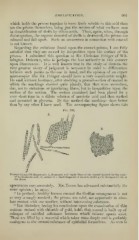Page 591 - My FlipBook
P. 591
AMELIFICA HON. 601
which holds the prisms together is more freely soluble in this acid than
are the prisms themselves, being just the reverse of what we have seen
in decalcification of shells by dilute acids. Then, again, when, through
disintegration, the organic material of shells is destroyed, the prisms are
released and tall apart. Sucli an occurrence in connection with enamel
is not known.
Regarding the striations found upon the enamel-prisms, I am fully
satisfied that they are caused by inequalities upon the surface of the
prisms. I submitted this question to Mr. Christian Febiger of Wil-
mington, Delaware, ^vho is perhaps the best authority in this country
upon Diatomacere. It is well known that in the study of diatoms the
very greatest nicety of judgment is necessary in order to diftereutiate
between such points as the one in hand, and the opinion of an expert
microscopist like Mr. Febiger should have a very considerable weight.
He said, without hesitancy, after studying a ground-section of enamel in
which the markings showed quite plainly, that they were ware-lines,
due, not to striations or interlacing fibres, but to inequalities upon the
surface of the section. The section examined had been placed for a
very short time in a dilute solution of muriatic acid and then washed
and mounted in glycerin. By this method the markings show better
than by any other I have used. The accompanying figure shows this
Fig. 336.
Enamel -Prisms (350 diameters) : A, fragments nnd single tibres of the enamel isolated bj- the actici
of hydrochloric acid; 1!, surface of a small fragment of enamel, showing the hexagonal ends of
the fibres.
appearance very accurately. INIr. Tomes has advanced substantially the
same opinion ; he says :
" In perfectly healthy human enamel the fibrillar arrangement is not
so very strongly marked ; the prisms are solid, are apparently in abso-
lute contact with one another, without intervening substance.
" But Bodecker, basing his conclusions upon the examination of thin
sections stained with chloride of gold, holds that enamel is built up of
columns of calcified substance between which minute spaces exist.
These are filled by a material which takes stain deeply and is probably
analogous to the cement-substance of epithelial formations. As seen in


